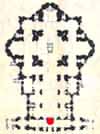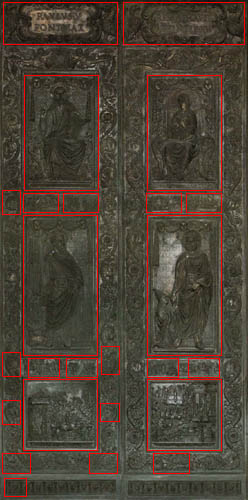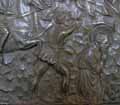| Grottoes
Vatican City Colonnade Saints Floorplan #2 |
| Altars
Monuments The History |
| Related
Items Holy Door Portico Portico Ceiling |
|
|
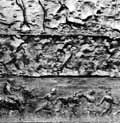 |
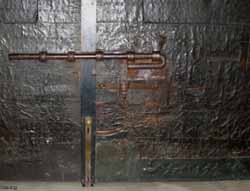 |
|
From: 'St. Peter's - Guide to Basilica and Square'
The central door is the oldest. Pope Eugene IV commissioned the Florentine,
Antonio Averulino, known as Filarete (1400-1469) to make the two bronze
imposts which he completed in 1445. The six panels show: Jesus the Savior
and Mary enthroned, the two centers of Christian piety, then as now; St.
Paul with the sword, the weapon with which he was beheaded and whose blade
is double-edged like God's words, and St. Peter, who is giving the keys
to the kneeling Pope Eugene IV, are the two pillars of the Church of Rome.
The two lowest panels show St. Paul sentenced by Nero and the martyrdom
of St. Paul, who kneels as, blindfold, he the stroke of the sword that
will take his life, and the martyrdom of St. Peter, dragged to the Vatican
Hill where he is crucified. St. Paul then appears to Plautilla, to give
her back the veil she had lent him to blindfold his eyes. The bas-reliefs
between the framed panels show scenes from the pontificate of Eugene IV,
and representatives at the Council of Ferrara-Florence, summoned in 1438
to reunite the Churches of the East and of the West.
From
'St. Peter's Basilica - A Virtual Tour' by Our
Sunday Visitor
Pope Paul V used the bronze door of the Old Basilica, commissioned to
Antonio Averulino, also known as Filarete by Pope Eugene IV, accomplished
already in 1455 by the Florentine workshop. It appears to be bound to
the medieval world, with Byzantine influences, though chronologically
a part of the Renaissance.
Among the four major compartments, Christ and the Virgin are represented in the upper part; St. Peter with Pope Eugene IV, kneeling before him, and St. Paul wielding a sword are represented in the center; the martyrdom of the two apostles with many details and interesting representations of ancient Rome, in the lower part. These compartments are separated by four horizontal bas-relief segments with the most important events of Eugene IV's papacy: episodes of the Council of Florence of 1438 for the decree of the union of the Greek and Roman churches, proclaimed by Eugene IV, and the arrival in Rome and the coronation of emperor Sigismund.
Vertical segments run around the entire door with garlands of flowers and leaves which are wound in spirals. In these decorations, called "girali (plant volutes)," Filarete inserts episodes taken from Aesop's fables, from the Metamorphosis of Ovid and from the Ecoglues of Horace. They are mainly decorative by nature.
On the lower back of the door, Filarete made a portrait of himself among his own disciples. Starting from the left, a knight on a donkey, and a figure on his right. In the central part, some of Filarete's assistants. Continuing to the right, Filarete himself holding a pair of compasses. At the right end of the scene, a knight on a dromedary. All of the figures bear their own name. The words "ANTONIUS ET DISCIPULI MEI" are shown on the two sides of Filarete. All the other figures bear their own name, from AGNOLUS to VARRUS.
Above the door a relief created by Bernini and his assistants represents the episode "Pasce Meas Oves," where Christ gives the Apostles the flock of the faithful.
From:
'Guide to Saint Peter's'
This is truly an historical door, as it was part of the old basilica.
It was made by the Florentine artist Antonio Averulino known as Filarete
(1400-1469) in the year 1455. The rich and elegant workmanship is a hymn
to Christ, the Virgin Mary and to the apostles Peter and Paul. At the
top are the Savior enthroned, giving a blessing, and the Virgin Mary,
humble and reverent. This was one of the most widely used themes in the
Middle Ages: the Church as a family. Where there is the Father, there
must also be the Mother, otherwise it would be cold and heartless.
In the center are the impressive standing figures of Peter and Paul, the two great pillars of the Roman Church. Paul holds a sword, symbol not only of his martyrdom, but of that double-edged blade, the word of God. At his feet is an elegant vase of flowers. Peter is the keeper of the keys. He is depicted as holding the Gospel in one hand and giving the keys over to the kneeling Pope Eugenius IV who had commissioned this door.
The last two panels show the Apostles condemned to death by Nero seated on his throne. Peter is being forcibly led to the Vatican hill where he would be crucified upside down. Paul, on the other hand was a Roman citizen, and met a less cruel death. He was made to kneel, he was blindfolded and he was beheaded with a single stroke of a sword. We see Paul, in the middle of the same panel as he emerges from a cloud to return the veil to Plautilla: the girl had given it to him to cover his eyes before he was executed.
From: 'The Companion
Guide to Rome' by Georgina Masson
The doors were made .. by command of Eugenius IV for Old St Peter's, the
work occupying the artist for twelve years, from 1433 to 1445. Eugenius
was the pope who presided over the famous Council of Florence in 1439
which sought to bring about the union of the churches in the face of the
Turkish threat. The Emperor John Palaeologos came to it with the Orthodox
Patriarch of Constantinople, also representatives of many of the other
oriental churches, including - to everyone's astonishment - some Ethiopian
monks.
The Ethiopian monks,
wearing turbans and long flowing robes, but with recognizably African
features, are seen kneeling before Eugenius and making a visit to Rome,
in the relief under the figures of St Peter and Pope Eugenius on the right
of the door.
We enter the basilica, by the doors to the right of the central ones and should start by looking at the back of those central ones, where, low down on the right one, we will find Filarete's 'signature'. The central seven figures are easily recognizable as Filarete and his assistants executing what seems to be a joyous dance with the tools of their profession in their hands (Filarete is the leader on the right). There is some doubt as to the interpretation of the somewhat shaggy dog-Latin inscription above them, as it is full of mistakes and colloquialisms, but it is generally accepted to mean that while others go the money and credit for the work, Filarete at least had the fun of it. Even more cryptic are the two figures at either end, one seated on an ass and the other on a camel, playing the pipes; so far no scholar has been able to arrive at an explanation of their significance.
-------------
Filarete's doors, although technically they are often compared unfavorably
with Lorenzo Ghilberti's bronzes, they are textbook examples of how to
incorporate a politico-theological argument into the design of a public
monument.
The Byzantine Empire made a comeback around 1300 under the new ruling house of the Palaeologues. Emperor John VIII appealed for support against the Turks. Greek delegates were dispatched to the Church Council at Basel, the meetings are depicted on the upper right hand panel of the door. The hat of the man on the throne is important because it was only worn by the Palaeologan emperor and unknown until the 1430s tour and appeal for aid, it appears frequently from then on in Renaissance art to designate someone as the Byzantine emperor, or a Roman emperor of the past in modern dress.
The scene showing the eastern emperors blessing given to theological negotiations in Basel is exhibited as one of Pope Eugenius' trophies of achievement. On the left hand door, Eugenius himself is depicted re-ordaining the Patriarch of Byzantium. The entire work is in fact a manifesto for the reunification of the antique empire under the patronage of the papacy.
